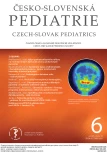Narcolepsy in childhood – our experiences
Authors:
V. Kučeravá; L. Remeň; P. Ďurdík; A. Ďurdíková; S. Suroviaková; Peter Bánovčin
Authors‘ workplace:
Klinika detí a dorastu, Jesseniova lekárska fakulta v Martine, Univerzita Komenského v Bratislave, Univerzitná nemocnica Martin, Slovensko
Published in:
Čes-slov Pediat 2021; 76 (6): 313-319.
Category:
Case Report
Overview
Narcolepsy is a chronic neurological disease characterized by a disorder of sleep cycle regulation. It is classified as hypersomnia in the classification of sleep disorders. The incidence of this disease is estimated at 1:2000, but it is often under diagnosed in childhood. There is no etiology currently fully elucidated, hypocretin deficiency is thought. Diagnosis is based on detailed sleep history, standard all-night videopolysomnography examination with multiple sleep latency test (MSLT) and cerebrospinal fluid hypocretin determination. Disease due to its nature leads to a reduced quality of life in patients.
We present case reports of three patients from the Department of Children and Adolescents of University Hospital in Martin with newly diagnosed narcolepsy based on the above procedures, two patients also underwent collection of cerebrospinal fluid to determine hypocretin levels with a positive result.
Keywords:
Narcolepsy – polysomnography – children – hypersomnia – MSLT – hypocretin
Sources
1. Nevšímalová S, et al. Clinical features of childhood narcolepsy. Can cataplexy be foretold? Eur J Paediat Neurol 2011; 15 (4): 320–325.
2. Sateia M. International classification of sleep disorders. Chest 2014; 146 (5): 1387–1394.
3. Příhodová I. Poruchy spánku u dětí a dospívajících. Praha: Maxdorf, 2013: 81–84.
4. Zhou J, et al. Case report of narcolepsy in a six-year-old child initially misdiagnosed as atypical epilepsy. Shanghai Arch Psychiatry 2014; 26 (4): 232–235.
5. Franceschini Ch, et al. Narcolepsy treatment: pharmacological and behavioral strategies in adults and children. Sleep Breath 2020; 24, 615–627. https://doi.org/10.1007/s11325- 019-01894-4.
6. Black J, et al. The burden of narcolepsy disease (BOND) study: health-care utilization and cost findings. Sleep Med 2014; 15 (5): 522–529.
7. Postiglione E, et al. The clinical spectrum of childhood narcolepsy. Sleep Med Rev 2018; 3: 70–85.
8. Mignot E, et al. Complex HLA-DR and-DQ interactions confer risk of narcolepsy-cataplexy in three ethnic groups. Am J Hum Genet 2001; 68 (3): 686–699.
9. Sarkanen T, et al. Incidence of narcolepsy after H1N1 influenza and vaccinations. Systematic review and meta-analysis. Sleep Med Rev 2018; 38: 177–186.
10. Mahlios J, de la Herrán-Arita A, Mignot E. The autoimmune basis of narcolepsy. Curr Opin Neurobiol 2013; 23 (5): 767–773.
11. Nevšímalová S. Disorders associated with increased sleepiness. In: Nevšímalová S, Bruni O. Sleep Disorders in Children. Springer, 2017: 281–304.
12. Morse AS. Narcolepsy and psychiatric disorders: Comorbidities or shared pathophysiology? Med Sci (Basel) 2018; 6 (1): 16.
13. Adamík P, et al. Špecifiká vybraných porúch spánku v detskom veku. Čes-slov Pediat 2010; 65 (10): 598–605.
14. Nevšímalová S, Příhodová I. Význam spánkové medicíny v pediatrii. Čas Lék čes 2019; 158: 323–327.
Labels
Neonatology Paediatrics General practitioner for children and adolescentsArticle was published in
Czech-Slovak Pediatrics

2021 Issue 6
Most read in this issue
- Edwards syndrome – phenotype, prognosis, ethical attitudes, professional and palliative care
- Not every hemangioma is a hemangioma...
- Systemic lupus erythematosus with hematological symptoms – a multifaceted disease: case reports and summary for clinical practice
- Specifics of care for tracheostomized pediatric patients – relevant topic
